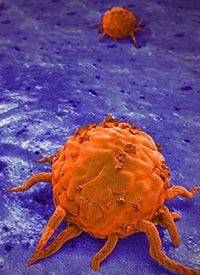Surufatinib Induces Robust Responses in US Patients with Extrapancreatic and Pancreatic NETs
Surufatinib demonstrated strong antitumor activity along with a manageable safety profile in heavily treated US patients with progressive extrapancreatic neuroendocrine tumors or pancreatic NETs, according to interim phase 1 data.

Surufatinib demonstrated strong antitumor activity along with a manageable safety profile in heavily treated US patients with progressive extrapancreatic neuroendocrine tumors (ep-NETs) or pancreatic NETs (pNETs), according to interim phase 1 data presented in a poster at the 2021 NANETS Annual Meeting.1
In the findings presented at NANETS, investigators evaluated 16 patients with epNETs and 16 with pNETs in a dose-escalation and -expansion trial to evaluate the safety and efficacy of surufatinib in a US population. Results of the dose-expansion phase showed that the objective response rate was 6.3% (95% CI, 0.2%-30.2) in the epNET cohort and 18.8% (95% CI, 4.0%-45.6%) in the pNET group; all responses in both groups were partial responses. The disease control rates were, respectively, 93.8% (95% CI, 69.8%-99.8%) and 87.5% (95% CI, 61.7%-98.4%).
The 11-month progression-free survival (PFS) rate was 51.1% (95% CI, 12.8%-80.3%) in the epNETs cohort and 57.4% (95% CI, 28.7%-78.2%) in the pNETs cohort. The median PFS was 11.5 months (95% CI, 6.47-11.50) in the epNET group and 15.2 months (95% CI, 5.19–not reached) in the pNET group.
In the phase 1, dose-escalation/-expansion trial, the recommended phase 2 dose was set at 300 mg of daily surufatinib in the dose-escalation phase, which was the same dose established in phase 3 trials conducted in China. In the US trial, patients in the epNET cohort received a median of 8 cycles (range, 2-15) of treatment while the median was 8.5 (range, 2-23) in the pNET cohort. Seven patients remained on treatment at the June 2020 data cutoff.
The primary end point was investigator-assessed PFS rate at 11 months. Secondary end points included safety and pharmacokinetics.
Regarding patient characteristics, the median age was 63.3 years and 68.8% of patients in both cohorts were male. The baseline ECOG performance status was 0 or 1 for all patients. Those in the epNET arm received a median of 2 prior lines of therapy (range, 2-5) compared with 4 (range, 1-8) in the pNET arm. Thirty-two patients with heavily pretreated progressive NETs were enrolled in the dose-expansion phase. Seven patients remained on treatment (4 with epNETs and 3 with pNETs) remained on treatment at the June 30, 2020 data cutoff date. The median number of cycles received was 8 (range, 2-15) and 8.5 (range, 2-23) for the epNETs and pNETs groups, respectively.
Safety results were consistent with earlier findings from the phase 3 Chinese SANET-p (NCT02589821) and SANET-ep (NCT02588170) trials, in which investigators evaluated surufatinib in the pNET and epNET populations, respectively.
In the data presented at the 2021 NANETS Annual Meeting, the most common grade 3 or higher treatment-emergent adverse events (TEAEs) were hypertension (37.5%) and diarrhea (12.5%) in the epNET group and hypertension (37.5%) in the pNET group.
Serious AEs were observed in 43.8% of patients. Seven (21.9%) patients required treatment discontinuation due to AEs. Nine (28.1%) needed dose reductions and 18 (56.3%) needed dose interruptions due to TEAEs.
Based on the SANET-p data, the National Medical Products Administration of China approved surufatinib in June 2021 for the treatment of patients with advanced pNETs. Additionally, the FDA accepted the filing of a new drug application for surufatinib as a potential treatment option for patients with pNETS and epNETS.2 The agency slated to decide on the application by April 30, 2022, under the Prescription Drug User Fee Act.
In SANET-p, 172 adult patients with progressive, advanced, well-differentiated pNETs were randomly assigned to daily oral surufatinib at 300 mg (n = 113) or placebo (n = 59) in 4-week treatment cycles.3
The median PFS per investigator assessment was 10.9 months (95% CI, 7.5-13.8) with surufatinib vs 3.7 months (95% CI, 2.8-5.6) with placebo (HR, 0.49; 95% CI, 0.32-0.76; P = .0011). An independent data monitoring committee recommended termination of the trial, as it met the early stopping criteria at the interim analysis.
The safety data showed that the most frequent grade 3 or higher treatment-related adverse effects (TRAEs) included hypertension (38% vs 7%), proteinuria (10% vs 2%), and hypertriglyceridemia (7% vs 0%). Serious TRAEs occurred in 22% and 7% of those in the investigative and control arms, respectively. Three on-treatment deaths occurred on the surufatinib arm vs 1 on the placebo arm.
In SANET-ep, 198 patients with unresectable or metastatic, well differentiated, epNETs were assigned to the same schedule of surufatinib (n = 129) or matching placebo (n = 69) in a 2:1 randomization.4
Here, the investigator-assessed median PFS was 9.2 months (95% CI, 7.4-11.1) vs 3.8 months (95% CI, 3.7-5.7) with placebo (HR, 0.33; 95% CI, 0.22-0.50; P <.0001). Similarly, an independent data monitoring committee again recommended termination because the study met the early stopping criteria.
Regarding safety, the most common grade 3 or higher in patients who received surufatinib or placebo included hypertension (36% vs 13%) and proteinuria (19% vs 0%). Twenty-five percent of patients in the investigation arm experienced serious TRAEs compared with 13% for those in the control arms. Three patients who received surufatinib died, which were related to treatment compared with 1 who received placebo.
References
- Li D, Paulson S, Tucci C, et al. Interim analysis results of surufatinib in US patients with neuroendocrine tumors (NETs). Presented at: 2021 NANETS Annual Meeting; November 3-6, 2021; virtual. Abstract 105.
- US FDA accepts filing of HUTCHMED’s NDA for surufatinib for the treatment of advanced neuroendocrine tumors. News release. July 1, 2021. Accessed July 1, 2021. https://bit.ly/3ycuQdd
- Xu J, Shen L, Bai C, et al. Surufatinib in advanced pancreatic neuroendocrine tumours (SANET-p): a randomised, double-blind, placebo-controlled, phase 3 study. Lancet Oncol. 2020;21(11):1489-1499. doi:10.1016/S1470-2045(20)30493-9
- Xu J, Shen L, Zhou Z, et al. Surufatinib in advanced extrapancreatic neuroendocrine tumours (SANET-ep): a randomised, double-blind, placebo-controlled, phase 3 study. Lancet Oncol. 2020;21(11):1500-1512. doi:10.1016/S1470-2045(20)30496-4



